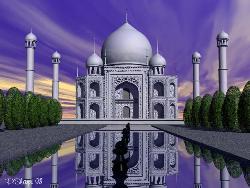Is TAJ MAHAL really symbolises the ETERNAL LOVE?
By newindipost
@newindipost (168)
India
October 28, 2006 3:34am CST
Is TAJ MAHAL really symbolises the ETERNAL LOVE?
Do you know the story behind it?
Taj Mahal stands on the bank of River Yamuna, which otherwise serves as a wide moat defending the Great Red Fort of Agra, the center of the Mughal emperors until they moved their capital to Delhi in 1637. It was built by the fifth Mughal emperor, Shah Jahan in 1631 in memory of his second wife, Mumtaz Mahal, a Muslim Persian princess. She died while accompanying her husband in Burhanpur in a campaign to crush a rebellion after giving birth to their 14th child. The death so crushed the emperor that all his hair and beard were said to have grown snow white in a few months. When Mumtaz Mahal was still alive, she extracted four promises from the emperor: first, that he build the Taj; second, that he should marry again; third, that he be kind to their children; and fourth, that he visit the tomb on her death anniversary. He kept the first and second promises. Construction began in 1631 and was completed in 22 years. Twenty thousand people were deployed to work on it. The material was brought in from all over India and central Asia and it took a fleet of 1000 elephants to transport it to the site. It was designed by the Iranian architect Ustad Isa and it is best appreciated when the architecture and its adornments are linked to the passion that inspired it. It is a "symbol of eternal love"
So what do you think?
No responses





